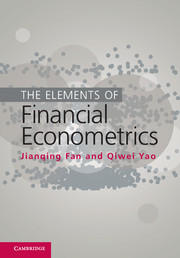Spring Semester, 2025
MW 9:30 - 10:50 in 101 Sherred Hall
| Publication | Details |
|---|---|

| Fan, J. and Yao, Q. (2015). The Elements of Financial Econometrics (383pp). Science Press, Beijing Table of Contents, a sample chapter, Figures and Computer Programs To order the book from amazon.com To order the book from China, Shipping Information |
General Information
Instructor: Jianqing Fan, Frederick L. Moore'18 Professor of Finance. Office: 203b BCF and 205 Sherred Hall. Phone: 258-7924. E-mail: [email protected]
Office Hours: Monday 2:00pm--3:00 pm (205 Sherred Hall), Tuesday 2:00pm--3:00pm (203b JRR, BCF), Wednesday 11:00am –- 12:00pm (203b JRR, BCF), or by appointments.
Precept: Arranged periodically by the AI
Assistants in Instruction (AIs)
- Xiaonan Zhu, [email protected], 258-9433, Office: 222 Sherred Hall
Office Hours: Tuesday, 3:00--4:00pm and Thursday, 11:00-12:00pm - Financial Econometric Lab, 222 Sherred Hall, 258-9433,
Statistics Lab, 213 Sherred Hall, 258-8787
Text Book
- Fan, J. and Yao, Q. (2015). The Elements of Financial Econometrics (383pp). Science Press, Beijing
- Lectures are primarily based on the lecture notes and text book with the following references.
Reference Books
- J.Y. Campbell, A.W. Lo and A.C. MacKinlay (1997): The Econometrics of Financial Markets, Princeton University Press
- Tsay, R.S. (2010). Analysis of Financial Time Series (Third edition), John Wiley & Sons.
Syllabus
This course covers econometric and statistical methods as applied to finance. Topics include
- Asset returns and efficient markets (Lecture Note 1 Homework 1)
- Linear time series and dynamics of returns (Lecture Note 2 Homework 2)
- Discrete time volatility models of returns
- Multivariate time series and volatility (assigned reading)*
- Efficient portolios and CAPM
- Multifactor pricing models
- Portfolio allocation and risk assessment
- Comsumption-based CAPM
- Present value models
- Simulation methods for financial derivatives
- Econometrics of continuous time finance
- Forecast and management of market risks*
Computation
The software package for this class is R. See R-labs below. Most of computation in this class can be done through a laptop. Laptops with wireless communication off can be used during the exams, and so are the calculators.
Attendance
Attendance of the class is required and essential. The course materials are mainly from the notes. Many conceptual issues and financial econometrics thinking are only taught in the class. They will appear in the midterm and final exams. In addition, random quizzes will be used to check understanding and attendance.
Homework
Problems will be assigned through canvas. No late homework will be accepted. Missed homework will receive a grade of zero. The homework will be graded, and each assignment carries equal weight. You are allowed to work with other students on the homework problems, however, verbatim copying of homework is absolutely forbidden. Therefore each student must ultimately produce his or her own homework to be handed in and graded.
Exams
There will be one in-class midterm exam, and a final exam. All exams are required and there will be no make-up exams. Missed exams will receive a grade of zero. All exams are open-book and open-notes. Laptops with wireless off and calculators may be used during the exams.
Schedules and Grading Policy
| Assignment | Schedule |
|---|---|
| Homework (25%) | Various due dates (5 sets) |
| Midterm Exam (25%) | Wednesday, March 19, 2025 (9:30--10:50am, in class) |
| Final Exam (45%) | Thursday, 9:30am--12:30pm May 1, 2025 at Room A17, JRRB1 |
| Class participation (5%) | class hours. |
R-labs
The following files intend to help you familiar with the use of R-lab commands.
Here are some useful materials too.
- An Introduction to R, by W. N. Venables, D. M. Smith and the R Core Team.
- U-Tube video: An introduction to R
- Labs 1-5: Basic skills and their associated data set (Boston housing data)
- The following extended skills are not used in the class, but is provided here for your convinience.
- Extended Skills: ANOVA and their associated data set (labor data).
- Extended Skills: GLIM and their associated data set (burn data). Description of the data set
- The following extended skills are not used in the class, but is provided here for your convinience.
- Lab 6: Linear time series analysis
- Lab 7: Discrete volatility models
- Lab 8: Capital Asset Pricing Model
Datasets used in class
Daily Data Sets
- Closing Prices of SP500: From 1/3/50 to 01/23/2019
- Closing Prices of Merck Co.: From 1/2/70 to 01/23/2019
- Dividends of Merck Co: From 6/2/70 to 12/14/18 (quaterly)
Weekly Data Sets
- Yields of 3-month Treasury Bills: From 1/8/82 to 01/18/2019
- Yields of 5-year Treasury Notes: From 1/5/62 to 01/18/2019
- Yields of 10-year Treasury Bonds: From 1/5/62 to 01/18/2019
- Ford (From May 29, 1972 to January 21, 2019)
Monthly Data Sets
- Apple (From January 1990 to January 2019)
- Ford (From January 1990 to January 2019)
- GE (From January 1990 to January 2019)
- IBM (From January 1990 to January 2019)
- Intel (From January 1990 to January 2019)
- Johnson & Johnson (From January 1990 to January 2019)
- Merk (From January 1990 to January 2019)
- Microsoft (From January 1990 to January 2019)
- S&P 500 (From January 1950 to January 2019)
- 3-month T-bill rates (From January 1934 to Feb/2011)
- 3-month T-bill rates (From January 1982 to December 2018)
- 10-year T-bond rates (From April 1953 to December 2018)
- Fama-French 3 Factors Fama-French 5 Factors Details
- 6 Portfolios Formed on Size and Book-to-Market (2 x 3) Details
- 25 Portfolios Formed on Size and Book-to-Market (5 x 5) Details
- SP500 Dividend, Dividend Yield, PE ratio, Earning, Real Price (in Dec 2018 dollar), (Jan. 1871-Dec. 2018)
- SP500 PS and PB ratios, (quarterly, Dec. 99--Dec. 2018)
- Comsumer Price Index (Jan. 1871 -- Dec. 2018)
- Personal Consumption (Jan. 1959 -- Nov. 2018)

